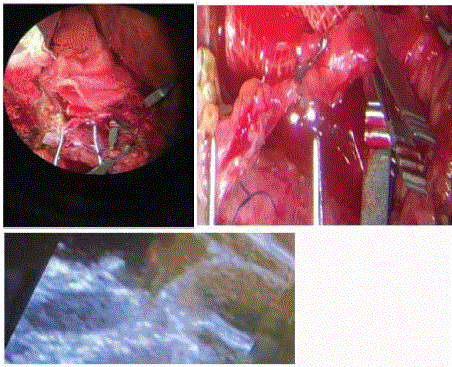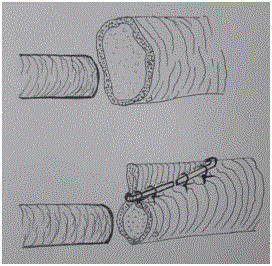Clinical Image
Using the Vessel Ligature Clip to Make the Mismatched Hepatic Artery Microsurgical Anastomosis Easier and Effective
Levent Yalçin*
Departemnt of Orthopaedics and Traumatology, Selcuk University, Konya, Turkey
*Corresponding author: Levent Yalçin, Departemnt of Orthopaedics and Traumatology, Selcuk University, Konya, Sakayik sokak No: 58/1 Nisantasi, İstanbul, Turkey
Published: 05 Oct, 2017
Cite this article as: Yalçin L. Using the Vessel Ligature Clip
to Make the Mismatched Hepatic Artery
Microsurgical Anastomosis Easier and
Effective. Clin Surg. 2017; 2: 1651.
Clinical Image
There are some specific challenges in microsurgical anastomosis of mismatched Hepatic
Arteries in Living Donor Liver Transplantation. Hepatic Artery anastomosis is an important part of
the Liver Transplantation from living donor [1,2]. Mismatching of arterial diameter is not unusual.
Most of the arteries could be anastomosed end to end after stretching the artery which has a narrow
diameter. Also sometimes doing a very shallow fish mouth incision on the artery which has narrow
diameter is very helpful for anastomosing with the other artery. But if mismatching between arterial
diameters are more than 30% to 50% these techniques are not enough. Cone-shaping is a wellknown
technique to make narrow the wide diameter artery to adopt the other one. Classic technique
is performed by cutting and suturing the end wall of the artery by creating a semi-cone. Especially
if there is a big discrepancy like 3 or 4 times more between arterial diameters old cone-shaping
technique is not very practical and also time consuming.
In such circumstances I like to make the larger diameter artery cone-shaped using the vessel
ligature clips. I apply the clip to the artery end wall from outside with approximately 30 degree angle to its longitudinal axis (Figure 1-3). This angle is important to create
less jet stream in the anastomosis side. In some cases, applying a one
middle size clip is suitable. Also in some cases I use a double small
size clip (Figure 4). Applying the safety sutures to prevent unexpected
movement of the clip could also be recommended. There is not any
knowledge about this technique in the literature. The advantages of
this technique are that it consumes less time and also less arterial
ischemia for transplanted liver.
Figure 1-3
Figure 1-3
Apply the clip to the artery end wall from outside with approximately 30 degree angle to its longitudinal
axis.
Figure 4
References
- Alper M, Gundogan H, Tokat C, Ozek C. Microsurgical reconstruction of hepatic artery during living donor liver transplantation. Microsurgery. 2005;25(5):378-83.
- Piskin T, Demirbas T, Yalcin L, Yaprak O, Dayangac M, Guler N, et al. Recipient splenic artery utilization for arterial re-anastomosis in living donor liver transplantation: single-center experience. Hepatogastroenterology. 2012;59(116):1263-4.


